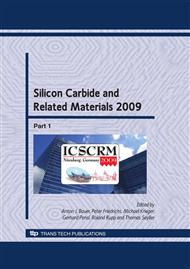p.689
p.693
p.697
p.701
p.705
p.709
p.713
p.717
p.721
Effects of Implantation Temperature on Sheet and Contact Resistance of Heavily Al Implanted 4H-SiC
Abstract:
Effects of implantation temperature on electrical properties of heavily-Al-doped 4H-SiC layer formed with Al implantation have been investigated. To form the p++ 4H-SiC with the original 4H-stacking structure, the implantation temperature above 175 °C is needed. A decrease in the implantation temperature below 250 °C leads to an increase in the NA-ND. It is suggested that an increase in the density of vacancies with a decrease in the implantation temperature promotes the Al substitution to lattice sites during activation annealing. The lower-temperature implantation also causes a decrease in activation energy for the p-type electrical conduction and a decrease in p-type ohmic contact resistivity. We presume that the increase in the Al acceptors at low-implantation temperatures gives expansion of the impurity bands and formation of valence band tail-states, causing the decrease in the impurity binding energy. The properties obtained with the lower-temperature implantation are desirable for practical applications especially at low temperatures.
Info:
Periodical:
Pages:
705-708
Citation:
Online since:
April 2010
Authors:
Price:
Сopyright:
© 2010 Trans Tech Publications Ltd. All Rights Reserved
Share:
Citation:


